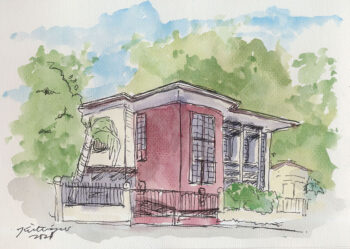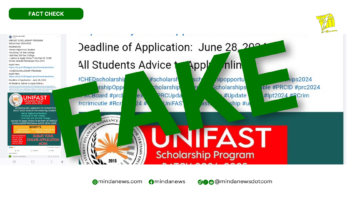IN ANOTHER David and Goliath move, a hundred armed Tausugs, led by Rajah Mudah (crown prince) Agbimuddin Kiram are in Lahad Datu, Sabah and have captured the attention of the world to the sovereign and proprietary claims of the Sulu sultanate over Sabah. Datu Agbimuddin and the brother of the Sulu sultan, Jamalul Kiram III, have stated that they are in Lahad Datu on a visit of their “homeland.” Since the sultanate is now part of the Philippines, the sovereign rights over Sabah have therefore been assumed by the Philippine government.
Left unresolved, the standoff in Sabah can escalate into an international incident that could create tension between Malaysia and the Philippines. Worse, there may be vested interests that will fuel an escalation into conflict. For instance, how true are the rumors from Malaysia that this incident may be driven by local politicians out to destabilize the ruling party, UMNO, by creating fear among the Sabahans? After all, the Malaysian government, under UMNO leaders, have been fully supporting the peace process with the Moro Islamic Liberation Front. News reports from Malaysia surmise that although Prime Minister Najib Razak is popular, the UMNO may be losing support. If this trend continues, then the opposition led by Datuk Anwar Ibrahim may have a stronger hand in challenging the UMNO in the June elections.
The Moro National Liberation Front, under chairman Nur Misuari, has been meeting in Zamboanga City since Wednesday about the situation. I have been informed that the discussions, which involve Muslim religious leaders from the islands, have leaders demanding support for the followers of the Sultan while calling for a peaceful resolution of the impasse.
With the Philippine government engaged in finalizing the peace agreement with the MILF, supported by the Malaysian government as facilitator, the impasse needs to be resolved peacefully. It is unfortunate that the government, under then President Gloria Macapagal-Arroyo, did not consider the Sabah claim as a major issue that could undermine the effectiveness of Malaysia as facilitator. This, in spite of statements issued by Moro leaders in 2001 that questioned the choice of Malaysia as facilitator amid the Sabah claim.
However, the Malaysian government has been effective in facilitating the GPH-MILF peace process since 2001 as well as an ally for security and development. It is therefore in the interest of all concerned that the Sabah stalemate be quickly and peacefully resolved. This close to the last stage of the peace process, we cannot afford a conflagration that could bring us all back to square 1.
Allow me to provide a background on the Sabah issue so that readers may understand the complexity of the situation. The government has been pursuing its claim over Sabah since the administration of President Diosdado Macapagal. The claim emanates from the Sulu sultanate’s sovereign rights over Sabah, which was turned over to the (Philippine) government. The proprietary claim of the heirs to Sabah, however, originates from the decision of a British court when Malaysia was still under British rule.
THE SULU SULTANATE ACQUIRES SABAH
The Genealogy of the Sulu Royal Families, written by Sururul-Ain Ututalum (descendant of Dayang-Dayang Hadja Piandao and, therefore, an heir to Sabah) and Abdul-Karim Hedjazi, traced the close relationship between the royals of Brunei and Sulu. In the 1500s, Brunei Sultan Bolkiah was married to Sulu Princess Putri Laila, granddaughter of Shariful Hashim, first Sultan of Sulu. In the late 1600s, when Sultan Muaddin of Brunei was threatened by rebellion, he turned to his kin in Sulu for help. The rebellion was quelled. As a reward, the Brunei sultan gave resource-rich Sabah to the Sultan of Sulu. The property includes the “mainland of the island of Borneo commencing from the Pandassan River on the north-west coast and extending along the whole east coast as far as the Sibuco River in the south and comprising amongst other the States of Paitan, Sugut, Bangaya, Labuk, Sandakan, Kina Batangan, Mumiang, and all the other territories and states to the southward thereof bordering on Darvel Bay and as far as the Sibuco river with all the islands within three marine leagues of the coast.” The territory is defined in the agreement. (http://www.lawnet.sabah.gov.my/Lawnet/SabahLaws/Treaties/GrantBySultanOfSuluOfTerritoriesAndLandsOnTheMainlandOfTheIslandOfBorneo.pdf.)
SABAH BECOMES PART OF MALAYSIA
In 1763, Sultan Azimuddin signed a treaty allowing the British East Indies Co. to use Sabah and other territories. Tensions later developed between the sultan and the company, which prevented the effective implementation of the treaty until 1878. At this time, Baron Von Overbeck of the British East India Trading Co. entered into a lease agreement or padjak with Sultan Jamalul Alam. This company was later absorbed by the British North Borneo Co. which, in 1946, transferred sovereign rights over Sabah to Britain. When the Federation of Malaya was granted its independence from Britain in 1963, Sabah was one of the territories turned over to the newly established Malaysia.
SOURCE OF DISPUTE
The dispute revolves around the meaning of the term padjak. The Tausug padjak means lease whereas the British version used the term to mean “grant” or “cede.” Thus, the sultan’s heirs maintain that Sabah was merely leased to the company while Malaysia states that the Philippines has no claim because Sabah had been sold to British East India Trading.
The Malaysian government continues to pay lease money owed by British North Borneo to the descendants of the sultan to this day. The Malaysian government pays RM5,300 per year as rental for Sabah to the heirs since the formation of the Malaysian federation in 1963.
Today, the sum of RM5,300 — less than ₱75,000 — as annual rental barely covers the monthly rent of a house in Kuala Lumpur, Malaysia. The heirs, on their own, have attempted to renegotiate the terms of the padjak with the Malaysian government.
In 1996, Princess Denchurai Kiram, daughter of Princess Tarhata Kiram and administrator of her estate, wrote then Prime Minister Mahathir to raise the rental to $1,000,000. She also stated that she and the other heirs were willing to renounce the claim if Kuala Lumpurt will provide a fair settlement. The letter was ignored by Mr. Mahathir.
In June 2010, the Sulu provincial board passed a resolution supporting the demand of the heirs to increase the yearly payment to at least $500 million.
Weeks earlier, Mr. Misuari issued a statement calling the attention of Malaysia to settle the Sabah issue. Misuari’s first wife, the late Desdemona Tan, and present wife Ruayda, are heirs to Sabah since they are descendants of Dayang-Dayang (Queen) Hadja Piandao, who was acknowledged to have 3/8 share of Sabah.
In January 2001, Sultan Esmail Kiram II, the brother of Jamalul III, also wrote Mr. Mahathir, this time through President Gloria Macapagal Arroyo. Princess Denchurain’s daughter, Princess Tajmahal, was a co-signatory. According to reports, their demand was for $855 million.
SOVEREIGN RIGHTS
The late Ambassador Abraham Rasul, wazir or prime minister to Sultan Esmail Kiram (and later wazir to Sultan Mahakuttah, son of Esmail), had been authorized by the sultan to discuss the pursuit of the Sabah claim with Mr. Macapagal and, later, President Ferdinand Marcos. (Ambassador Rasul succeeded his father, the first Muslim senator, Hadji Butu, who was wazir to three sultans.)
Esmail Kiram officially transferred the sultanate’s authority and sovereignty to the Philippines on Sept. 12, 1962 through a written instrument signed by himself and Foreign Affairs Secretary Emmanuel Pelaez. The transfer was authorized by a resolution passed by the Ruma Bechara (literally “House of Talk,” equivalent to council of advisers/Cabinet). He thus gave up the Sulu sultanate’s sovereign rights to Sabah to the government, but retained proprietary rights over the same.
However, there was a provision in the Ruma Bechara resolution that in the event the government fails or refuses to protect its claim, the Sultanate of Sulu reserves the right to prosecute its claim over Sabah, in whatever manner it can think of. The Kiram family lawyer, Ulka Ulama, and former Senator Santanina Rasul have documents that bear this out. (As a UP political science student, Senator Rasul wrote an award-winning essay on the claim, which was published in the UP Law Journal.)
If the sovereign claim over Sabah is dropped, do we lose all rights? Even if we lose sovereign rights over Sabah, we still have proprietary rights, through the heirs of the Sultan, who personally owned Sabah.
THE HEIRS
The legally recognized owners — members of Sulu royalty and nobility — were identified in the 1939 ruling of Chief Justice C. F. C. Macaskie of the High Court of North Borneo: Dayang-Dayang (Princess) Hadji Piandao was acknowledged as the major share-holder with 3/8 share. Princess Tarhata Kiram and Princess Sakinur-In Kiram were to each have a 3/16 share. The six other heirs who went to Macaskie’s court were awarded 1/24 share apiece: Mora Napsa, Sultan Esmail Kiram, Datu Punjungan, Sitti Mariam, Sitti Jahara and Sitti Rada.
Princess Denchurain acknowledged the nine heirs specified in the Macaskie decision as the true heirs of Sabah.
All the principal heirs have died. As of today, there are probably a thousand heirs of the heirs. Dayang-Dayang Hadji Piandao Kiram, an only child, was childless. Therefore her cousins, nieces and nephews will divide her 3/8 share. Among her cousins was my grandmother, Hadja Salma, wife of Sen. Hadji Butu. Thus, my father, the late Ambassador Rasul, and his siblings and cousins are heirs. Misuari’s wives (Desdemona and Ruayda), are heirs. Jamalul III and Esmail are the children of Datu Punjungan.
MOVES TO RESOLVE CLAIM
During the term of President Macapagal, the government in 1962 filed a claim over Sabah with the United Nations. A Sabah Division was created in the Department of Foreign Affairs.
Mr. Marcos had other plans. Parallel to legal maneuverings, he had young Muslims trained in Corregidor to “destabilize” Sabah. The scenario: the Philippines could then come in and take Sabah by force, to “protect” the thousands of Tausugs who lived there or incite them to secede and join the Philippines. The plan went awry, resulting in the massacre of the Muslim trainees. Except for one lone survivor, Jibin Arula. Away from the barracks when he heard gunfire, Arula claimed he saw his comrades mowed down by their military trainors. He ran to the mountains, went over the cliff and into the sea. He was rescued the next day by Cavite fishermen. Somehow, he was brought to then Cavite Gov. Delfin Montano. The governor brought Arula to Senator Benigno Aquino who then exposed the infamous “Jabidah Massacre” of March 18, 1968. Malaysia severed diplomatic ties with the Philippines after the expose. It took the combined efforts of Indonesia, Singapore and Thailand to resolve the situation.
President Corazon C. Aquino wanted to resolve the claim during her term. It seems that Malaysia would only agree to negotiate if all the heirs spoke as one. In 1987, she instructed Foreign Affairs Secretary Raul Manglapus to bring all the heirs together. On Oct. 23, 1987, Mr. Manglapus wrote Ambassador Rasul: “I would like to suggest that the claimants organize themselves so that they may arrive at a common position…. Although yours is a private claim, we have the assurance of the Malaysian government that they are ready and willing to negotiate with the heirs of the Sultan of Sulu in order to settle this matter.”
Then Sen. Santanina Rasul was requested to coordinate the unification of the heirs. As her chief of staff, I was tasked to implement the assignment. We managed to bring them all to Malacañang. After hours of deliberation, the heirs appointed their representatives, led by Sec. Manglapus, to negotiate with Malaysia. Unfortunately, the meeting came to a standstill when Jamalul III dissented. Afterward, the heirs of Dayang-Dayang Hadji Piandao Kiram, Sultan Esmail Kiram, Princesses Tarhata, Sakinur-in and Sitti Mariam sought a meeting with Sec. Manglapus. A brief from that meeting held on Dec. 6, 1987, stated: “They were of the opinion that Sultan Mohamad Jamalul Kiram III was expressing his own personal views which contravene the consensus reached at the meeting of the heirs with Secretary… Manglapus at the PICC on Friday, December 4 and at the conference of the heirs held with President Corazon C. Aquino at Malacañang on Saturday, December 5.”
President Fidel V. Ramos pursued the attempt to unite the heirs. Upon his suggestion, the representatives of the heirs met on Feb. 10, 1993 to discuss their establishment of the Sulu-Sabah Development Corp., which would be responsible for the economic development and sociocultural advancement of Sulu. It was understood that this entity would be the conduit of the funds from the settlement of the proprietary claim over Sabah. Former Presidential Legal Counsel (now Supreme Court Justice) Antonio Carpio drafted the terms. This corporation would have been powerful if the idea had prospered.
Why then did the attempts fizzle? During the Ramos years, the heirs still could not unite. By then, the idea to establish the Brunei-Indonesia-Malaysia-Philippines East ASEAN Growth Area had prospered. Rich Malaysia was employing hundreds of thousands of Filipinos as well as investing in Mindanao. Terrorism was sprouting and borders had to be secured. The Sabah claim moved to the back burner. This situation continued through the short-lived Estrada presidency.
The Arroyo administration renewed interest in settling the claim. Some of the heirs were feted at Malacañang in 2002 and Jamalul III was hailed as Sultan of Sulu. President Gloria Macapagal-Arroyo even gave the letter of Sultan Jamalul and Princess Tajmahal, asking for an adjustment of the rentals, to then Prime Minister Mahathir. The Arroyo administration, however, did not unite all the heirs, as the preceding administrations had done.
THE SULTAN OF SULU
The Sultanate of Sulu has had a tradition of being governed by one Sultan, supported and acknowledged by the citizens of the sultanate. The last to be so proclaimed was Sultan Mahakuttah Kiram, the son of Esmail Kiram. Mahakuttah, was recognized by Mr. Marcos, while his father was recognized by Messrs. Macapagal and Marcos. Jamalul III was recognized by Mrs. Arroyo, and was even included in the administration senatorial slate in 2004. He has been the most forceful and visible sultan.
It is unfortunate that today there are over 10 who are claiming the Sultanship. Among them are Sultan Jamalul III and his brother Sultan Esmail. Jamalul is the eldest son of Datu Punjungan Kiram. Initially, Datu Punjungan was the raja muda or crown prince of Sultan Esmail Kiram. But after Datu Punjungan left the Philippines to reside in Sabah, Sultan Esmail was fearful that Datu Punjungan might sign a quitclaim in favor of Malaysia, so he changed his crown prince, with the consent and authority of his Ruma Bechara. Esmail named his eldest son, Mahakuttah Kiram, as his crown prince. When Esmail passed away, Mahakuttah succeeded and his coronation was ordered by Mr. Marcos to safeguard the Sabah claim. Mahakuttah had anointed his son, Muedzul-Lail as the raja muda. At the time, Muedzul-Lail was in grade school.
RECOMMENDATIONS
• The Sabah impasse needs to be resolved peacefully. It is to the interest of the government to ensure that the MNLF, the dominant Moro liberation front in Sulu, supports a peaceful resolution of the situation. Misuari can play a role to de-escalate tensions. Not only is he Tausug and therefore supportive of the sultanate, his late wife Desdemona and present wife Ruayda are heirs. However, Misuari is aggrieved that the MNLF and he himself have been sidelined in the peace process with the MILF. Further, the Arroyo administration had been instrumental in supporting the Council of 15, which removed Misuari from the leadership of the MNLF. He was also incarcerated for over seven years and later released for lack of evidence. Misuari, who is still recognized by the Organization of the Islamic Conference as the chairman of the MNLF, is therefore a key player. Misuari yesterday convened a meeting of the MNLF and island leaders in Zamboanga City on the situation in Sabah and the claim. A statement will be issued calling for support for the Sabah claim.
• The national government should encourage and assist the leading members of the Kirams and the datus of Sulu to come together and choose one Sultan. This will not only re-establish the tradition of one Sultan leading the Sulu sultanate; it will provide a focal point for the nobility and traditional leaders of Sulu to lead in peace and development. At this point, Sultan Jamalul Kiram III has established his dominance in the field, particularly after the Lahad Datu incident. Most of the leaders in the island-provinces of Sulu, Tawi-Tawi and Basilan — domain of the Sulu sultanate — have applauded his action.
As many elected leaders in the island-provinces have not been successful in forging a strong foundation of governance and peace, perhaps strengthening the institution of the sultanate will provide Sulu, Tawi-Tawi and Basilan with an institution that can help unite the population behind peace and development, as the sultans of Malaysia are doing.
• The Benigno Aquino administration should follow the initiative began by Presidents Corazon Aquino and Ramos to unite the Sabah heirs and pursue the peaceful and just resolution of the Sabah claim.
(MindaViews is the opinion sectionof MindaNews. This piece was first published on February 21, 2013 under “Surveil,” the column of Ms Amina Rasul for Businessworld. Ms Rasul granted MindaNews permission to reprint this piece).







